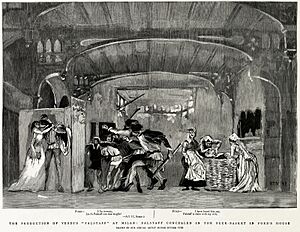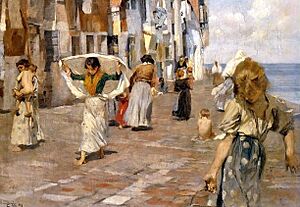Ettore Tito facts for kids
Ettore Tito (born December 17, 1859 – died June 26, 1941) was a famous Italian artist. He was especially known for his beautiful paintings of everyday life and landscapes in Venice and the areas around it. He studied art at the Accademia di Belle Arti in Venice. Later, from 1894 to 1927, he became a Professor of Painting there.
Tito's art was shown in many places, and he won big awards. He received the Grand Prize for painting at the 1915 Panama–Pacific International Exposition in San Francisco. In 1926, he became a member of the Royal Academy of Italy. Ettore Tito was born in Castellammare di Stabia near Naples, but he lived most of his life in Venice, where he also passed away.
Contents
A Young Artist's Journey
Ettore Tito was born on December 17, 1859, in Castellammare di Stabia. His father, Ubaldo Tito, was a ship captain, and his mother, Luigia Novello Tito, was from Venice. When Ettore was a small boy, his family moved to Venice. This city became his home for the rest of his life.
He started learning art very early. First, he studied with a Dutch artist named Cecil van Haanen, who became a lifelong friend. Then, at just 12 years old, he was accepted into the Accademia di Belle Arti. This was even before he was old enough to officially join! At the Accademia, he learned mostly from Pompeo Marino Molmenti. He finished his studies and graduated when he was 17.
Ettore Tito's Amazing Career
Early Successes and Awards
Ettore Tito's first big success came in 1887. His painting Pescheria vecchia a Venezia (which means "Old Fish Market in Venice") showed the old fish market on the Rialto. This painting received great praise at an art show in Venice. Later, it was bought by the Galleria Nazionale d'Arte Moderna in Rome.
Tito's artwork was shown widely and became popular even outside Italy. His paintings were featured in almost every Venice Biennale from its start in 1895 until 1914. They were also shown again in 1920 after World War I. He won the "City of Venice Prize" in 1897 and a "Grand Gold Medal" in 1903 at the Biennale. In 1909, a whole room at the Biennale was dedicated to his work, showing 45 paintings and a bronze sculpture of Pegasus.
International Recognition
His painting Chioggia won a Gold medal at the 1900 Exposition Universelle in Paris. It was later bought by the Musée du Luxembourg. Another painting, La gomena (The Cable), won the Grand Prize at an exhibition in Brussels in 1910. In 1915, he won the Grand Prize for Italian painting at the Panama–Pacific International Exposition in San Francisco. In 1926, 18 of his paintings were shown in Los Angeles. This was the same year he became a member of the Royal Academy of Italy.
Changing Art Styles and Illustrations
At first, Tito's paintings mostly showed people, daily life, and landscapes of Venice and the Veneto region. After 1900, he started painting more mythological and symbolic scenes. These were inspired by 18th-century Venetian art. He used these themes for his oil paintings and for the murals he created in places like the Villa Berlinghieri in Rome.
By the late 1800s, his drawings and sketches were also very popular. They appeared in several British and American magazines, including The Graphic, Scribner's Magazine, and Punch. One of his illustrations, Aide-toi, le ciel t'aidera ("Heaven helps those who help themselves"), is kept at the Victoria and Albert Museum.

Teaching and Social Life
Tito was friends with many English and American artists and writers who lived in Venice. He was close to famous artists like John Singer Sargent and Isabella Stewart Gardner. His family homes, Villa Tito and Palazzotto Tito, were popular meeting spots for artists, musicians, and writers. He painted portraits of many of his friends and their families.
In 1894, Ettore Tito took over from Pompeo Molmenti as the Professor of Painting at the Accademia in Venice. He held this important job until 1927. Some of his students became famous artists themselves, including Eugenio Da Venezia and Cagnaccio di San Pietro.
Later Works and Legacy
One of his most important projects later in life was in 1929. At 70 years old, he was asked to paint a huge 400-square-meter painting for the ceiling of the Chiesa di Santa Maria di Nazareth church in Venice. This new painting replaced an older one by Tiepolo that was destroyed during World War I.
His last major work, I maestri veneziani (The Venetian Masters), was finished in 1937. It was shown at the Venice Biennale in 1940. This painting is seen as his "spiritual testament." It shows Venice as a young woman surrounded by the city's greatest artists, like Tiepolo, Veronese, Titian, and Tintoretto.
Death and Family Legacy
Ettore Tito passed away in Venice on June 26, 1941, at the age of 81. His son, Luigi Tito (1907–1991), also became a well-known painter. Ettore's grandson, Pietro Giuseppe (Eppe) Tito (born 1959), is a famous sculptor. In 2003, an exhibition showed the works of Ettore, Luigi, and Pietro Giuseppe Tito together at the Villa Pisani in Stra.
Ettore Tito's Artworks
Famous Paintings
Many of Tito's paintings are owned by private collectors. Here are some of his works that are permanently displayed in museums:
- La pescheria vecchia a Venezia (The Old Fish Market in Venice) (1887) – Galleria Nazionale d'Arte Moderna, Rome
- Breezy Day in Venice (1891) – Museum of Fine Arts, Boston
- Autunno (Autumn) (1897) – Galleria Internazionale d'Arte Moderna, Venice
- Chioggia (1898) – Musée d'Orsay, Paris
- The Wave (1902) – Museo de Arte Italiano, Lima
- La nascita di Venere (The Birth of Venus) (1903) – Galleria Internazionale d'Arte Moderna, Venice
- L'amazzone (The Amazon) (1906) – Frugone Collection, Museo Villa Grimaldi Fassio, Genoa
- Il bagno (The Bath) (1909) – Musée d'Orsay, Paris
- La gomena (The Cable) (1909) – Galleria Nazionale d'Arte Moderna, Rome
- Oxen Plowing (1911) – Brooklyn Museum, New York City
- Autoritratto (Self-portrait) (1919) – Galleria degli Uffizi, Florence
- L'aria e l'acqua (Air and Water) (1922) – Art Gallery of New South Wales, Sydney
Notable Murals
Ettore Tito also created large frescos and ceiling paintings for important buildings:
- Villa Berlinghieri, Rome (painted 1917) – Tito painted a series of frescoes for the entry hall. These showed themes like Fruits of the Earth, Play, Study, and Repose.
- Palazzo D'Anna Viaro Martinengo Volpi di Misurata, Venice (painted 1921) – For this palace on the Grand Canal, Tito painted a ceiling in the ballroom. It showed Italy's victory over Libya.
- Chiesa di Santa Maria di Nazareth (Chiesa degli Scalzi), Venice (completed 1934) – Tito created a huge painting for the church's nave vault. It replaced a famous fresco by Tiepolo that was destroyed in World War I. Tito's painting, called Gloria di Maria dopo il Concilio di Efeso, shows the Council of Ephesus declaring Mary the Mother of God.
Images for kids
See also
 In Spanish: Ettore Tito para niños
In Spanish: Ettore Tito para niños




